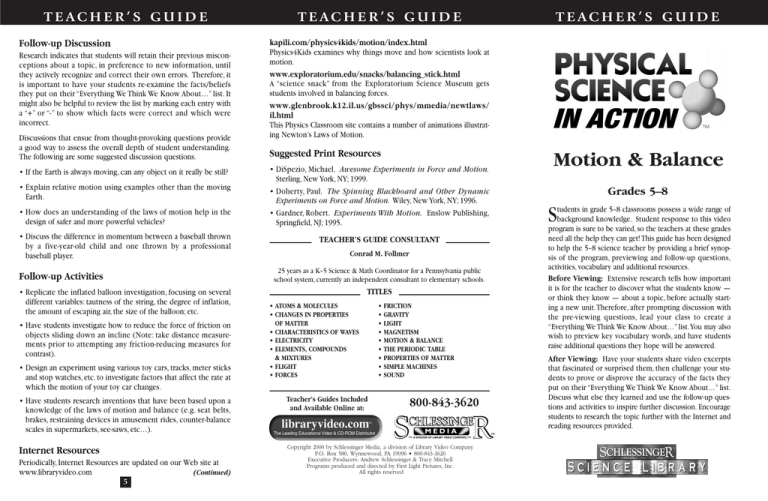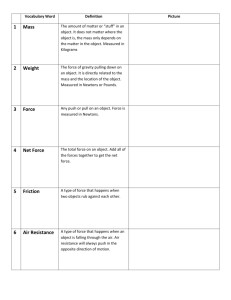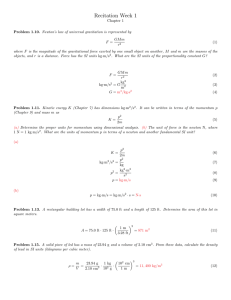
TEACHER’S GUIDE
Follow-up Discussion
Research indicates that students will retain their previous misconceptions about a topic, in preference to new information, until
they actively recognize and correct their own errors. Therefore, it
is important to have your students re-examine the facts/beliefs
they put on their “Everything We Think We Know About…” list. It
might also be helpful to review the list by marking each entry with
a “+” or “-” to show which facts were correct and which were
incorrect.
Discussions that ensue from thought-provoking questions provide
a good way to assess the overall depth of student understanding.
The following are some suggested discussion questions.
• If the Earth is always moving, can any object on it really be still?
• Explain relative motion using examples other than the moving
Earth.
• How does an understanding of the laws of motion help in the
design of safer and more powerful vehicles?
• Discuss the difference in momentum between a baseball thrown
by a five-year-old child and one thrown by a professional
baseball player.
TEACHER’S GUIDE
TEACHER’S GUIDE
kapili.com/physics4kids/motion/index.html
Physics4Kids examines why things move and how scientists look at
motion.
www.exploratorium.edu/snacks/balancing_stick.html
A “science snack” from the Exploratorium Science Museum gets
students involved in balancing forces.
www.glenbrook.k12.il.us/gbssci/phys/mmedia/newtlaws/
il.html
This Physics Classroom site contains a number of animations illustrating Newton’s Laws of Motion.
Suggested Print Resources
Motion & Balance
• DiSpezio, Michael. Awesome Experiments in Force and Motion.
Sterling, New York, NY; 1999.
• Doherty, Paul. The Spinning Blackboard and Other Dynamic
Experiments on Force and Motion. Wiley, New York, NY; 1996.
• Gardner, Robert. Experiments With Motion. Enslow Publishing,
Springfield, NJ; 1995.
Grades 5–8
S
tudents in grade 5–8 classrooms possess a wide range of
background knowledge. Student response to this video
program is sure to be varied, so the teachers at these grades
need all the help they can get! This guide has been designed
to help the 5–8 science teacher by providing a brief synopsis of the program, previewing and follow-up questions,
activities, vocabulary and additional resources.
Before Viewing: Extensive research tells how important
it is for the teacher to discover what the students know —
or think they know — about a topic, before actually starting a new unit.Therefore, after prompting discussion with
the pre-viewing questions, lead your class to create a
“Everything We Think We Know About…” list.You may also
wish to preview key vocabulary words, and have students
raise additional questions they hope will be answered.
TEACHER’S GUIDE CONSULTANT
Conrad M. Follmer
25 years as a K–5 Science & Math Coordinator for a Pennsylvania public
school system, currently an independent consultant to elementary schools.
Follow-up Activities
• Replicate the inflated balloon investigation, focusing on several
different variables: tautness of the string, the degree of inflation,
the amount of escaping air, the size of the balloon; etc.
• Have students investigate how to reduce the force of friction on
objects sliding down an incline (Note: take distance measurements prior to attempting any friction-reducing measures for
contrast).
• Design an experiment using various toy cars, tracks, meter sticks
and stop watches, etc. to investigate factors that affect the rate at
which the motion of your toy car changes.
• Have students research inventions that have been based upon a
knowledge of the laws of motion and balance (e.g. seat belts,
brakes, restraining devices in amusement rides, counter-balance
scales in supermarkets, see-saws, etc…).
Internet Resources
Periodically, Internet Resources are updated on our Web site at
www.libraryvideo.com
(Continued)
5
TITLES
• ATOMS & MOLECULES
• CHANGES IN PROPERTIES
OF MATTER
• CHARACTERISTICS OF WAVES
• ELECTRICITY
• ELEMENTS, COMPOUNDS
& MIXTURES
• FLIGHT
• FORCES
Teacher’s Guides Included
and Available Online at:
• FRICTION
• GRAVITY
• LIGHT
• MAGNETISM
• MOTION & BALANCE
• THE PERIODIC TABLE
• PROPERTIES OF MATTER
• SIMPLE MACHINES
• SOUND
800-843-3620
S
R
CHLESSINGE
MEDIA
A DIVISION OF LIBRARY VIDEO COMPANY®
Copyright 2000 by Schlessinger Media, a division of Library Video Company
P.O. Box 580, Wynnewood, PA 19096 • 800-843-3620
Executive Producers: Andrew Schlessinger & Tracy Mitchell
Programs produced and directed by First Light Pictures, Inc.
All rights reserved
TM
After Viewing: Have your students share video excerpts
that fascinated or surprised them, then challenge your students to prove or disprove the accuracy of the facts they
put on their “Everything We Think We Know About…” list.
Discuss what else they learned and use the follow-up questions and activities to inspire further discussion. Encourage
students to research the topic further with the Internet and
reading resources provided.
Program Summary
Nothing in the universe is at rest. With the Earth spinning and
whizzing through space, everything is actually in motion. However,
the only way we can tell that things are in motion is to compare
them to other things nearby. This is called relative motion. For
example, if you are traveling in a moving car, things outside of the car
appear to be moving past you, while the things and people inside of
the car do not, because they are moving at the same speed. Forces are
what give an object the energy to move, to stop moving and to
change direction. Some forces cause motion while other forces
oppose motion. For example, a baseball which has been hit eventually slows down and falls back to Earth because of the forces of friction and gravity. If it were not for these outside forces, the
momentum of the ball — which is its mass times velocity — would
keep it moving forward. Equilibrium is the balance of opposing
forces and is achieved when an object is at rest. Because it takes a
force — a push or a pull — to move an object, unbalanced forces are
responsible for changes in motion.
motion — A change in the speed or position of an object relative to
the things around them.
force — A push or a pull on an object, causing a change in motion.
After the class has completed their “Everything We Think We Know
About…” list, ask them what other questions they have that they
hope will be answered during this program. Have students listen
closely to learn if everything on their class list is accurate and to
hear if any of their own questions are answered.
gravity — The fundamental force of attraction between all objects.
The more mass an object has, the greater the force of its gravity.
Focus Questions
velocity — The speed and direction of an object.
friction — The force that opposes movement between objects that
are touching.
balanced forces — When opposing forces push and pull equally on
an object with no change in motion.
equilibrium — The condition when all forces are balanced and
there is no change in motion of an object.
Sir Isaac Newton (1642–1727) — English physicist and mathematician who studied gravitational forces and motion and is considered
the founder of physical science. Newton formulated the theory of
gravity and developed the Laws of Motion.
Sir Isaac Newton, an English scientist who lived during the 17th and
18th centuries, studied motion and described three universal laws.
The First Law of Motion states that an object in motion will stay in
motion, without slowing down, unless acted upon by an outside
force. Similarly, without a force acting on it, an object at rest will stay
at rest. This is also called the principle of inertia, which is the property of matter that causes an object to resist any change in motion.
Newton’s Second Law of Motion deals with acceleration, which is any
change in speed or direction. Changes in how fast or which way
something moves are directly caused by the strength of the force
acting on an object. Both the force acting upon an object and its mass
determine its velocity. Newton’s Third Law of Motion states that for
every action, there is an equal and opposite reaction.
Newton’s First Law of Motion — Objects at rest will stay at rest
and objects in motion will stay in motion, unless acted upon by an
unbalanced force.
The Laws of Motion can be seen with a rocket launch. For a rocket to
lift off, force must be exerted (First Law).The speed of the rocket will
be determined by the mass of the rocket and the force produced by
the fuel (Second Law). The motion of the rocket is equal to, and
opposite from, the force of the engine (Third Law) in which the
downward force of the rocket engines pushes the rocket upwards,
with an equal force. A demonstration with a balloon on a line
reinforces this concept.
Newton’s Third Law of Motion — For every action, there is always
an opposite and equal reaction.
Vocabulary
• What forces are involved when a baseball is hit into the air? After a
The following words are included for teacher reference or for use with
students. They are listed in the order in which they appear in the video.
• What does it take to change the motion of an object?
inertia — The property of matter which causes an object to resist a
change of direction or speed.The amount of inertia depends upon
the object’s mass.
momentum — The mass of an object times its velocity. The greater
the momentum of an object, the harder it is to slow it down.
Newton’s Second Law of Motion — The acceleration of an object
is directly related to the force exerted on that object and oppositely
related to the mass of that object.
acceleration — Any change in an object’s direction or rate of speed.
Pre-viewing Discussion
Before students generate their list of “Everything We Think We Know
About…” for this topic, stimulate and focus their thinking by raising
these questions so that their list will better reflect the key ideas in
this show:
baseball is hit, what makes it fall back to the ground?
(Continued)
(Continued)
2
1. How can we be moving when we are standing still?
2. What is motion?
3. As you drive down the road in a car, why do objects inside the
car appear to be stationary when compared to the objects
outside of the car?
4. How do forces cause motion?
5. What are “opposing forces”?
6. How can opposing forces become balanced?
7. What are some examples of a natural force?
8. Who was Sir Isaac Newton?
9. What is Newton’s First Law of Motion?
10. How can inertia be explained?
11. What is momentum?
12. What factors are involved in the momentum of a moving
object?
13. Why does it take more force to stop a rolling boulder than a
rolling basketball?
14. What is net force?
15. What happens when net force equals zero?
14. What is the definition of acceleration?
15. What is Newton’s Second Law of Motion?
16. How does the “Newton’s Cradle” toy demonstrate Newton’s
Third Law of Motion?
17. What are some examples of Newton’s Third Law of Motion in
action?
18. What did the experiment with the inflated balloon demonstrate?
19. Why is it less difficult to balance a bicycle when it is moving
forward than when you first get on it?
20. How can high-speed motorcycles go around turns, almost on
their sides, without falling?
3
4





